SDJV37 Interim Report FY03
SDJV37 Interim Report FY04
SDJV37 Interim Report FY05
Food resources available to sea ducks on migration at the Restigouche River in New Brunswick, Canada and potential contaminant problems

Project Number: 37
Year Funded: 2005 (year endorsed)
Lead Institution(s): Patuxent Wildlife Research Center
Project Lead: Matthew Perry
Collaborator(s): Keith McAloney (CWS)
Location: New Brunswick
Focal Species: Black Scoter (Melanitta americana)
Project Description: Approximately 100,000 Black Scoters use the Restigouche River in New Brunswick, Canada every spring as a staging area before movement north to breeding areas in Quebec and Manitoba. The coastline of the Restigouche River has paper mills and power plants, possibly contributing contaminants that could accumulate in the food resources available for seaducks feeding in these areas during migration. This project contributes to the understanding of the potential role of these contaminants to scoter populations. Objectives include: 1) Determining what benthic food organisms are available for migrating seaducks in the Restigouche River and 2) Determining food habits of seaducks feeding in the Restigouche River, to create a baseline database of available food resources in the area.
Project Reports:
